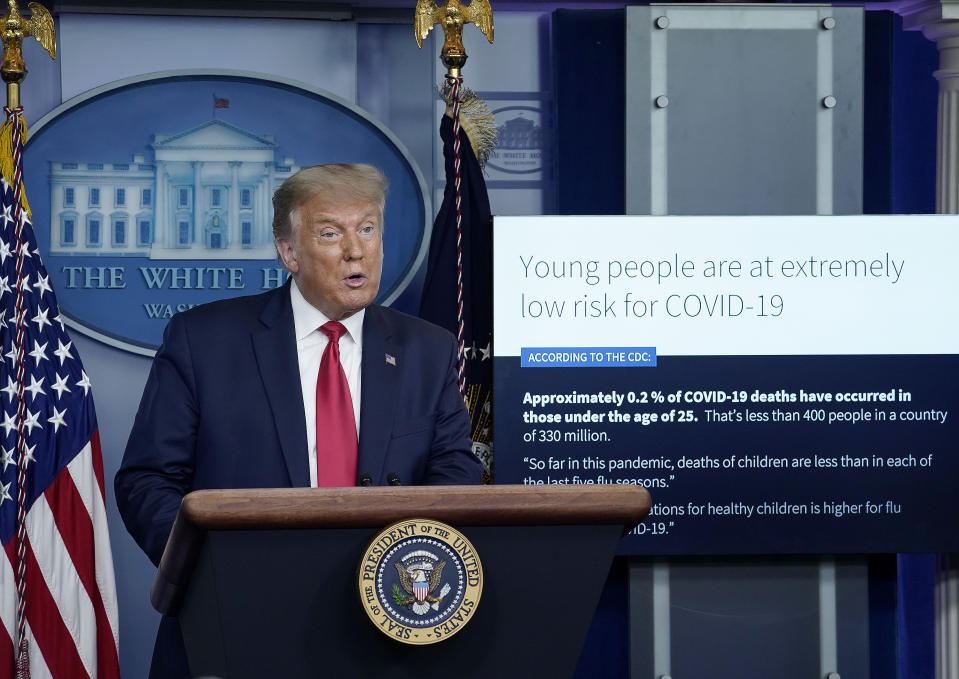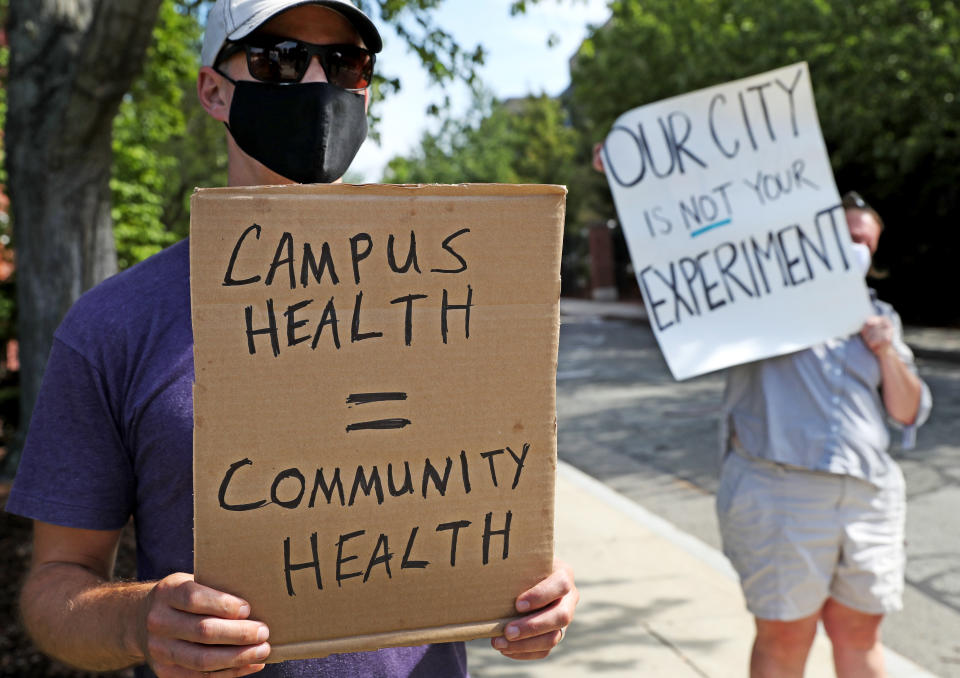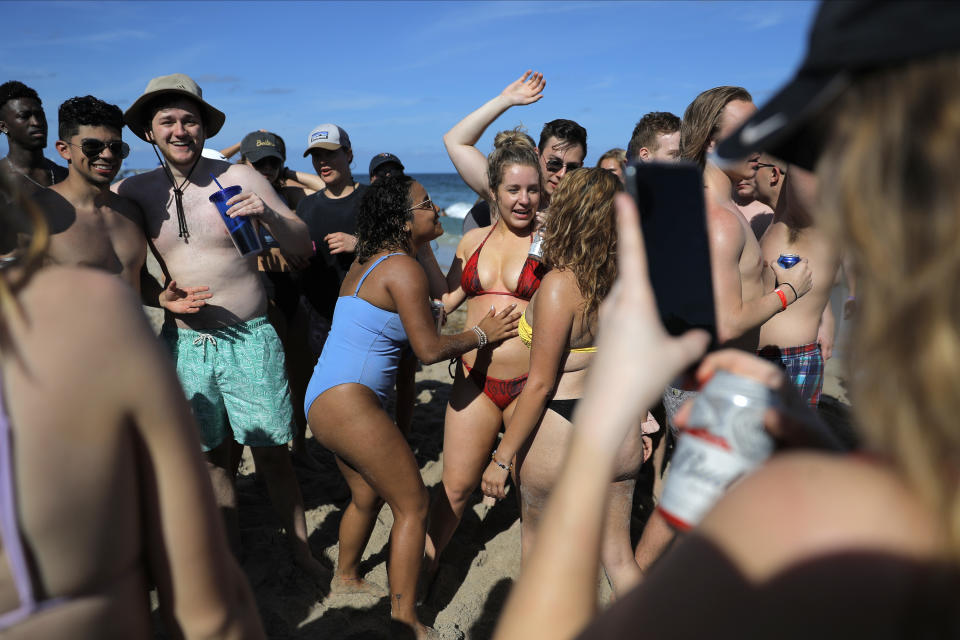Trump's belief that colleges are 'low risk' may overlook long-term COVID-19 complications
At a Sept. 10 White House news conference, President Trump doubled down on his call for college and university campuses to remain open at all costs. A nearby screen with a chart titled “Colleges and universities are extremely low-risk environments” listed dozens of colleges and universities that had reported hundreds of cases of COVID-19, none of which had resulted in hospitalizations, while the president insisted that it is “crucial for colleges and universities to stay open” and that “it’s much safer for students to live on campus.”
This was yet another in a series of instances where Trump has bashed universities for closing despite outbreaks and repeatedly insisted on schools remaining open. The Centers for Disease Control and Prevention has emphasized the importance of children returning to school this fall, and at last week’s news conference Trump repeated CDC statistics on the significance of in-person learning, particularly for low-income and minority students.

According to tracking by the New York Times, so far there have been over 88,000 cases of COVID-19 in over 1,190 colleges across the U.S., with more than 150 colleges reporting at least 100 cases through the course of the pandemic. Sixty college- or university-related COVID-19 deaths have been recorded, though the Times notes that most of these deaths were in the spring and involved college employees, not students. And while there have been reports of students being hospitalized with the coronavirus, those cases have been relatively few in comparison with the number of infections.
In a country of about 19.7 million college students, these statistics may seem promising. But Yahoo News medical contributor Dr. Dara Kass says that even for young college-age people, getting infected “is not simply risk-free,” and that such an assessment by the White House overlooks the long-term consequences and persistent complications that COVID-19 survivors can encounter. Some young COVID-19 victims have reported symptoms lasting weeks and even months after their diagnosis. During a keynote address at the American Society for Microbiology on Aug. 17, top infectious disease expert Dr. Anthony Fauci said the long-term effects of COVID-19 in young adults are troubling.
“We have seen that even individuals who are young and otherwise healthy — and get symptomatic enough to be in bed for a week or two but don’t require hospitalization — may have residual symptoms for weeks to months after clearing the virus,” Fauci said. “We’re seeing a substantially high proportion of cardiovascular abnormalities. Evidence of myocarditis. Evidence of emerging cardiomyopathy. Evidence of inflammatory processes in the brain. And these are people who have recovered from the disease.”
The extent of the long-term complications of COVID-19 is still largely unknown, but the Mayo Clinic notes that even in young people, COVID-19 can cause strokes and seizures and, according to a recent paper from researchers in Brazil, may increase the risk of developing Parkinson’s disease or Alzheimer’s disease later in life. This theory is supported by the notion that certain viral infections may trigger changes in the brain similar to those in Parkinson’s, and the paper alludes to previous studies reporting that people who were born or were young at the time of the infamous 1918 influenza outbreak had “a 2- to 3-fold higher risk” of developing Parkinson’s. The authors of the paper, however, caution that further research is still needed.

The Mayo Clinic also notes that the virus’s impact on the lungs can result in scar tissue that may lead to long-term breathing problems. Johns Hopkins Medicine says that initial damage to the lungs caused by COVID-19 can be followed by scarring and that it may take “three months to a year or more” to return to pre-COVID-19 lung functioning and that patients may require long-term respiratory therapy.
“We are seeing young people develop heart conditions, lung conditions. Student athletes have complications that will affect them probably for the next 10, 20, 30 or 50 years of their life,” Kass says.
With no nationwide plan for school reopenings, learning environments like elementary, middle and high schools across the U.S. have sporadically opened — and sometimes closed again — with a myriad of public health regulations and remote versus in-person learning options. But Kass says colleges and universities encounter unique challenges when choosing how and whether to open their own campuses.
“It’s not the learning environment itself that’s risky, it’s really where are the college students living,” Kass says. “Are they living on campus? Off campus? Are they living in a house or a building with over 50 people and eating in a common area? And more importantly, what are they doing with their time when they are not at class?”
College parties have emerged as hotbeds of coronavirus infections and the source of many outbreaks on college campuses. At Miami University in Ohio, where more than 1,000 students have tested positive for COVID-19 since classes started this fall, according to WKRC, one group of college students even hosted a party over Labor Day weekend despite testing positive for the virus a week earlier.
“The universities can set up as much testing as they want,” Kass says. “They can have as many regulations as they want. They can put as many mask rules as they want. But if college students after class, on the weekends and off campus are not following those rules, then there’s going to be no protection against the unmitigated and totally overwhelming spread of this virus on college campuses and in college towns.”

One aspect of college life in particular has been a contentious topic of nationwide debate: sports. Last month the Big Ten Conference made the decision to cancel college football, much to the dismay of many fans, players, coaches — and the president, who repeatedly pushed for college football to resume.
“People are working very, very hard to get Big Ten football back, and I’m pushing it, and it will be a great thing for our country and players,” Trump said at last week’s White House news conference.
On Wednesday the Big Ten Conference reversed its decision, saying college football would resume the weekend of Oct. 24. Trump took credit for the change of course, tweeting Wednesday morning, “It is my great honor to have helped!!!”
“The truth is, it depends on the university, on their disease prevalence, on their student body, on the ability to test and trace people,” Kass says of whether college sports should go ahead this fall. “So there is no blanket answer on whether or not football or basketball should happen right now.”
But she says the key to keeping college campuses open isn’t college administrators — it’s college students.
“Please, mask up,” Kass advises college students. “Be responsible. Follow the rules, and you’ll get to stay at school.”
_____
Read more from Yahoo News:




